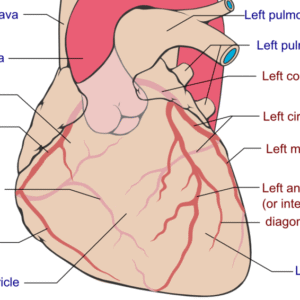Cardiology > Coarctation of the aorta (CoA)
Coarctation of the aorta (CoA)
Background
Coarctation of the aorta (CoA) is a congenital narrowing of a segment of the aorta, typically located just distal to the origin of the left subclavian artery near the ductus arteriosus (aortic isthmus). This narrowing creates a pressure gradient between the upper and lower extremities, leading to hypertension proximal to the lesion and hypoperfusion distal to it. Although often diagnosed and treated in infancy or childhood, some cases go undetected until adulthood, presenting with systemic hypertension or its complications.
II) Classification/Types
By Anatomic Location:
- Preductal (Infantile type): Narrowing proximal to the ductus arteriosus; often associated with other congenital anomalies and severe symptoms in infancy.
- Juxtaductal (most common): Narrowing at the site of the ductus arteriosus insertion.
- Postductal (Adult type): Narrowing distal to the ductus; usually discovered later due to the development of collateral circulation.
By Morphology:
- Discrete (shelf-like) narrowing
- Long-segment hypoplasia
- Associated anomalies: Bicuspid aortic valve, ventricular septal defect, cerebral aneurysms, and mitral valve abnormalities.
Pathophysiology
The narrowing causes increased afterload for the left ventricle, leading to concentric hypertrophy. Proximal hypertension develops due to resistance to flow, while distal hypoperfusion stimulates the formation of collateral vessels (e.g., intercostal arteries). Chronic hypertension contributes to endothelial dysfunction, aortic rupture risk, and premature atherosclerosis. Severe coarctation can lead to heart failure or aortic dissection if untreated.
Epidemiology
- Accounts for 5–8% of all congenital heart defects
- Male predominance (2:1 ratio)
- Frequently associated with Turner syndrome (XO)
- Often coexists with bicuspid aortic valve (~50–85% of cases)
Etiology
I) Causes
- Congenital malformation of the aortic arch during embryogenesis
- May arise in isolation or with syndromic associations (e.g., Turner syndrome)
II) Risk Factors
- Genetic syndromes (Turner, Williams)
- Family history of congenital heart disease
- Maternal diabetes or teratogenic exposures during pregnancy
Clinical Presentation
I) History (Symptoms)
- Children/Infants: Poor feeding, failure to thrive, respiratory distress (in severe preductal cases)
- Adults: Headaches, epistaxis, fatigue, leg claudication, cold lower extremities
- Signs of heart failure: Dyspnea, orthopnea in severe cases
- Often asymptomatic and found on routine hypertension workup
II) Physical Exam (Signs)
- Upper extremity hypertension with lower extremity hypotension
- Weak or delayed femoral pulses (radio-femoral delay)
- Systolic murmur over the left infrascapular area or back
- Intercostal retractions or rib notching (from collateral arteries)
- Left ventricular heave (from hypertrophy)
Differential Diagnosis (DDx)
- Essential hypertension
- Peripheral artery disease
- Aortic dissection
- Vasculitis (e.g., Takayasu arteritis)
- Middle aortic syndrome
- Supravalvular aortic stenosis
Diagnostic Tests
Initial Evaluation
- Blood pressure measurement: Differential >20 mmHg between arms and legs
- ECG: Left ventricular hypertrophy (LVH)
- Chest X-ray: Rib notching, “figure 3 sign” (pre- and post-stenotic dilation)
- Transthoracic echocardiography (TTE): First-line for assessing gradient and anatomy
Advanced Imaging
- Cardiac MRI (preferred): Accurate delineation of anatomy and aortic arch
- CT Angiography: Useful in evaluating the site, extent of narrowing, and collaterals
- Cardiac catheterization: Hemodynamic assessment; often combined with intervention
Treatment
I) Acute Management
- Antihypertensive therapy (e.g., beta-blockers or IV vasodilators)
- Treat heart failure symptoms (e.g., diuretics)
- Prostaglandin E1 (in neonates) to maintain ductal patency if severe
II) Definitive Management
- Surgical repair (end-to-end anastomosis, subclavian flap, patch aortoplasty): Preferred in infants or complex anatomy
- Balloon angioplasty ± stenting: Common in adolescents and adults
- Hybrid approaches: May be used in recurrent or complicated cases
Medications
Drug Class | Examples | Notes |
Beta-blockers | Metoprolol, Atenolol | Control hypertension, reduce shear stress |
ACE Inhibitors | Lisinopril, Enalapril | Afterload reduction, especially post-repair |
Diuretics | Furosemide | Symptom relief in heart failure |
Vasodilators | Nitroprusside, Nicardipine | Used acutely in hypertensive crises |
Antiplatelets | Aspirin (post-stenting) | Prevent stent thrombosis |
Device Therapy
- Endovascular stents: For adult CoA or restenosis
- ICD or pacemaker: Rarely needed unless coexisting conduction abnormalities
- Ventricular assist device: For end-stage heart failure in complex cases
Patient Education, Screening, Vaccines
- Lifelong follow-up with congenital heart disease specialist
- Importance of BP monitoring and compliance with medications
- Screening for associated conditions (e.g., bicuspid aortic valve, cerebral aneurysms)
- Endocarditis prophylaxis if indicated post-intervention
- Update influenza and pneumococcal vaccinations
Consults/Referrals
- Adult congenital cardiologist: Essential for long-term management
- Cardiothoracic surgeon: For surgical correction
- Interventional cardiology: For balloon angioplasty/stenting
- Genetics: If associated syndromes suspected
- Obstetrics (MFM): For pregnancy management in affected women
Follow-Up
Short-Term
- Monitor post-intervention for complications (e.g., aneurysm, restenosis)
- BP control and assessment of LV function
- Echocardiogram and MRI at 6–12 months post-repair
Long-Term
- Periodic imaging every 3–5 years to assess aortic integrity
- Annual clinical evaluation for hypertension and cardiovascular health
- Screen for complications: recoarctation, aneurysm formation, cerebrovascular events
Prognosis
- Excellent with timely surgical or endovascular repair
- Long-term hypertension remains in ~30–50% of adults despite correction
- Risk of aortic aneurysm, stroke, and early coronary artery disease
- Lifelong surveillance is crucial for optimal outcomes and early detection of late complications
Stay on top of medicine. Get connected. Crush the boards.
HMD is a beacon of medical education, committed to forging a global network of physicians, medical students, and allied healthcare professionals.

